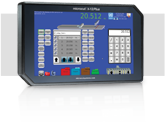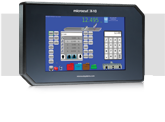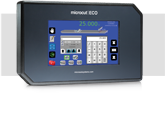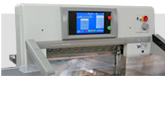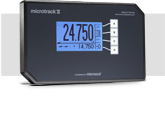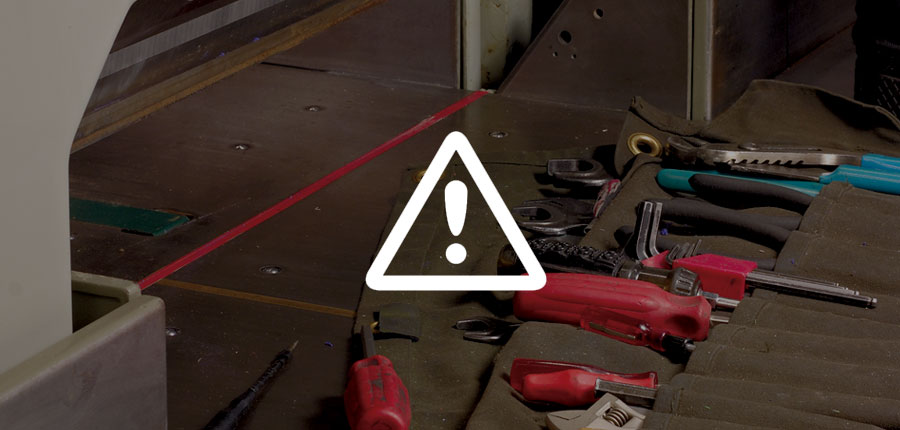Industrial paper cutters rely on fixed gauges, clamps and knives to cut accurately. Find out how to make adjustments to these systems and fix common cutting issues.
The process of cutting paper is at least in theory, very simple: material is aligned against fixed side gauges and a movable backgauge, a clamp holds the pile while a knife travels downward, cutting the material. In reality though, cutting is a lot more complicated. Failure to recognize and adjust for problems can result in inaccuracies during later processes and in the worst-case scenario, ruin a printing job. This costs time and money.
So what steps can be taken to avoid cutting inaccuracies on a heavy duty paper cutter? Let’s review:
First Step in Accurate Cutting
The size must be right
The first step in accurate cutting is to make sure two important factors on the commercial paper cutter are set correctly:
- measurement display
- squareness of the backgauge
Measurement display
All paper cutting machines have a system for displaying the position of the backgauge. Older machines have a ruler while newer ones have a computer display. The first step in avoiding cutting problems is to ensure that the display shows the correct position of the backgauge. The ability to recalibrate is a feature found on a number of industrial paper cutters and is a standard setup on retrofit computers. Checking for size is very simple: The backgauge is set to a displayed size and a sheet is cut. The cut sheet is measured and the actual size is compared to the displayed size. If there is a difference, an adjustment must be made based on each manufacturer’s procedure.
Squareness of the backgauge
The squareness of a guillotine paper cutter's backgauge (parallel to the knife) is critical to proper cutting. While each manufacturer has a different procedure for adjusting the backgauge, a very simple test can be used for checking squareness of the backgauge: A small, narrow pile is cut on both sides of the machine at the same time. The two piles are compared and if there is a difference in the size of the two piles, the backgauge is not square.
Get rid of parallelograms, and square the sheets
Sheets of paper and other materials that need to be cut are not always rectangles with 90° corners. In many cases, they are parallelograms (4 sided objects where the corners are not 90°). This causes a big issue when trying to align sheets into the square corner of a paper cutter formed by the side gauge and backgauge. The pile will not properly align in relationship to the knife, and the sheets will continue to be parallelograms. This can have a disastrous effect when running sheets through a press or a folder, or through any machine where you rely on the edges of the sheet to align properly.
The solution is to square the sheets on the paper cutter. This is accomplished on a heavy duty paper cutter simply by not trying to force the un-square corners of the sheet into the square corners on the paper cutting machine. The lift should first be aligned against the backgauge only (with printed sheets, the gripper edge should be placed against the backgauge).
When the lift is then cut, the "front edge" and the "rear edge" (against the backgauge) will then be parallel. The lift is then turned ninety degrees and one of the parallel edges is placed against the side gauge only and pushed back to barely rest against the backgauge. When the lift is cut, the result will then be a good 90° corner. This lift can now be turned and placed into the corner of the backgauge and the side guide to cut the last two edges.
Register: internal and external
When cutting printed sheets, the register factor comes into play in two forms: internal and external.
Internal register is the position of the images relative to each other.
External register is the position of the images relative to the sheet itself.
Internal register is the primary concern of the pre-press and press areas. Once sheets are printed, it can’t be adjusted. External register, while considered for pre-press in layout and on press when printing the sheet, becomes the primary concern of the cutting and finishing departments. While we can’t adjust the images for register, we can control their relative position in regard to the edges of the sheet. Paper can change size when printed and the decision may need to be made to cut to the image or cut to size.
This is why it’s important for the cutter operator to receive complete information and a rule out with each job. When setting up the cutter, a small lift or even a single sheet should be cut to check that everything works out correctly.
While today more and more is being done electronically (paper cutting machines cutting automatically from pre-press information), it is important to remember that paper is not a stable substrate. Under the effects of moisture, heat and pressure (all found on printing presses), paper size will change. Manufactures have offered off-line programming for a number of years but adjustments may still need to be made to paper during cutting. In complex cutting programs, adjustments may need to be made at various points to compensate for changes in the sheet.
Make sure the knife is sharp
One of the major causes of problems with a paper cutter is the use of a dull or blunt knife. Besides the inaccuracy of the cuts, the machine will be subject to unnecessary strain. See our guide to Caring for Industrial Paper Cutter Blades.
Signs that a paper cutter knife is blunt are:
- A rough or a speck-y smooth cutting edge, depending on the material
- A bang is heard when cutting the bottom sheets of a pile
- The cut material sticks together
- The cut edge of the material is ridge-like or turned down
- Inaccuracies in cutting (overcut, undercut, etc.)
Regular paper cutter blade sharpening is key to productivity and longevity of the machine.
Clamp pressure is the critical setting
To obtain maximum productivity on a paper cutter, we try to stack piles as high as possible. With the stacking of material, setting the clamp pressure becomes critical. The basic rule of thumb is to use higher clamping pressure for soft material and lighter pressure for hard material.
The clamp pressure selected should not be higher than necessary to avoid dislocation or dragging of sheets.
Lists of recommended pressure settings for different material are available from a number of paper cutter manufactures. These guidelines for clamp pressure settings, along with proper knife angle, become critical with working with different materials.
Find out how the Microcut Transcend® clamp/cut control system is replacing existing control systems for greater accuracy.
Figure 1 shows common mistakes or inaccuracies in paper cutting, as well as their cause and remedy:
Figure 1: Common mistakes in paper cutting and how to correct them
|
Condition
|
Possible Cause
|
Possible Remedies
|
|
Overcut: knife moves forward as it goes through the pile. The bottom sheets are longer.
|
Clamp pressure too high
Knife angle too acute
Knife is blunt
|
Reduce clamp pressure
Exchange knife
|
|
Undercut: knife moves backwards as it goes through the pile. The bottom sheets are shorter.
|
Clamp pressure too low
Knife angle too obtuse
Insufficient pre-clamping
|
Increase clamp pressure
Exchange knife
Extend time of initial clamping or pre-clamp
|
|
Mushroom cut: the first 4-5 sheets are longer then the rest of the pile, which is correct size.
|
Clamp pressure too low with soft material
Air gap between knife and clamp is too large
|
Increase clamp pressure
Guide gibs need to be adjusted by a specialist
|
|
Bow or Hollow cut: material is too short in places.
|
Thickness of stock varies
Wavy material
|
Use flexible false clamp plate or in cases of large differences, glue cardboard to clamp plate
|
Problems in paper cutting can be caused by a number of factors, including the material and the paper cutting machines themselves. They can be costly but if the right steps are taken, can also largely be avoided.
Have a commercial paper cutter problem we didn’t cover here? Contact a Colter & Peterson paper cutter expert. We’d be happy to help. We’ve been the Paper Cutter People since 1932 - it’s in our blood.
Related articles:
Caring for Industrial Paper Cutter Blades: Quality Cuts, Greater Savings
Finding The Best Industrial Paper Cutter: What You Need to Know, Part 1


